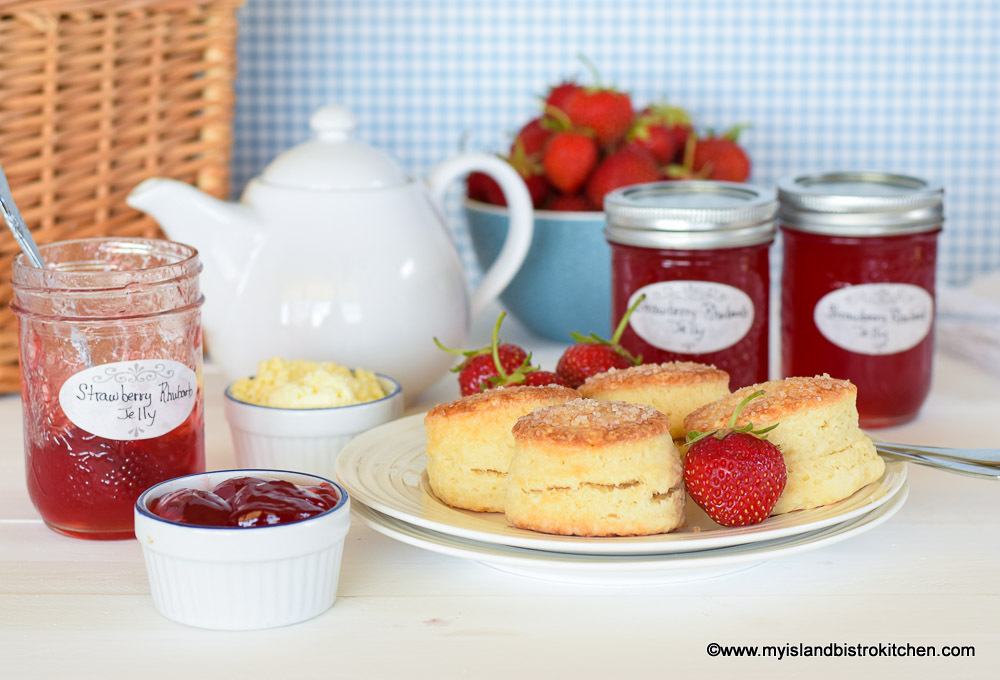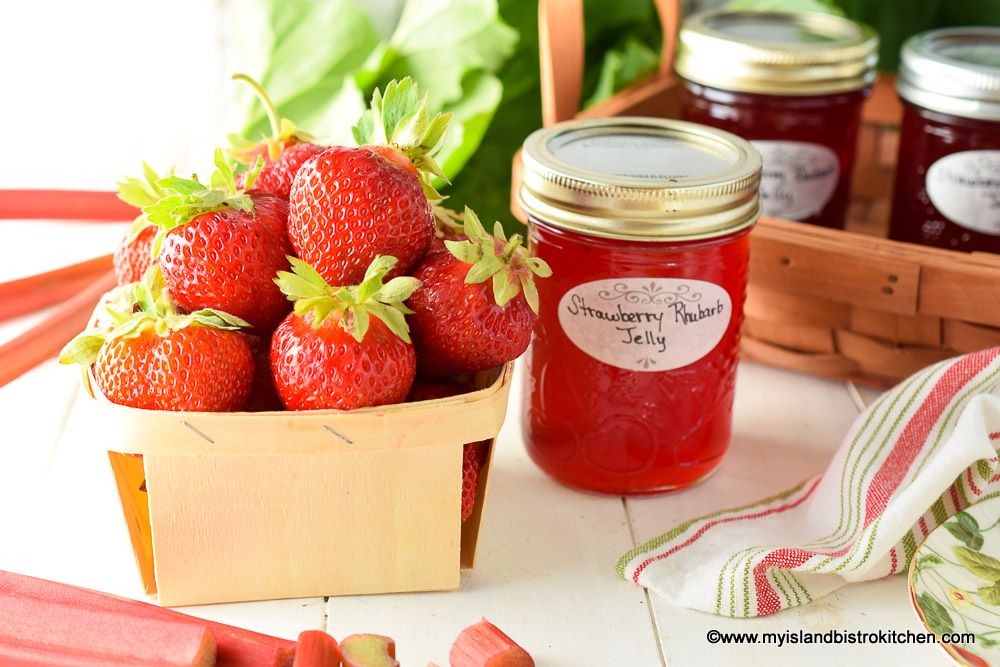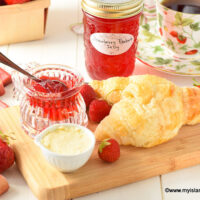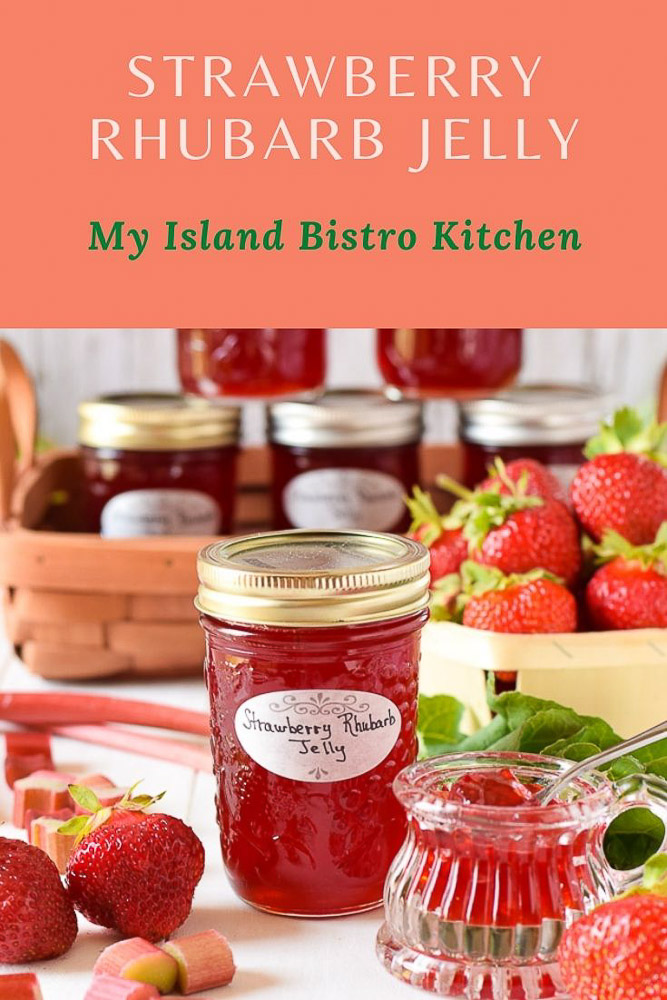
Strawberry and rhubarb are two of my favorite flavor combinations. It should come as no surprise, then, that I would create a Strawberry Rhubarb Jelly recipe. With its stunning color and beautiful flavor, this jelly is sure to become a family favorite.

Jelly making is very process oriented and sequential in nature. I recommend taking a few reads of the method for making this Strawberry Rhubarb Jelly before beginning. There is nothing particularly difficult about making this jelly but it does take time, attention, and organization. I recommend setting out all supplies and equipment before beginning any of the process of jelly making.
Juice is required to make jelly so the rhubarb and strawberries have to first be cooked until they are softy and mushy and then transferred to a fine mesh weave jelly bag and the fruit allowed to drain, on its own, to extract the juice. Refrain from trying to hasten on the process by squeezing the jelly bag as this will create a cloudy/murky jelly. Jelly should always be translucent and free of any impurities (i.e., bits of fruit pulp).

How long this process takes, well, it takes the length of time that it takes. It might be all dripped out in an hour or it could take a couple of hours or more. When you observe the jelly bag for a couple of minutes or so and no drip of juice is any longer visible, that’s a sign that the fruit has pretty well dripped out all the juice available.
If you have a formal jelly bag stand, by all means, use it. However, a jelly bag stand is not essential. A simple contraption constructed with two chairs and broomstick will work well. Simply fill the jelly bag with the cooked fruit, tie it closed with heavy string or kitchen twine, leaving a loop with which to slide it onto a broom stick handle suspended between two chairs with a large bowl under the jelly bag to catch the juice as it drips out. It may not be very sophisticated but it gets the job done!
The quantity of fruit called for in the recipe should yield the 3 cups of juice required of the recipe. However, the exact amount of rhubarb/strawberry juice extracted from the rhubarb and strawberries is hard to predict with 100% accuracy because so much depends on the quality and age of the rhubarb and strawberries and their water content as well as their growing conditions. If the strained amount is slightly less than the 3 cups required in this recipe, up to 1/3 cup of water may be added to yield 3 cups of liquid. That said, try to add as little water as possible to the juice as it will dilute or weaken the true strawberry rhubarb flavor. For this reason, you may wish to cook a wee bit extra rhubarb and strawberries if you are unsure if the produce you are using is of the quality that you can be assured it will juice out 3 cups. If it yields more than 3 cups of juice, only use the 3 cups called for in the recipe as adding more juice is likely to affect the gelling process.

This flavorful and colorful Strawberry Rhubarb Jelly is very versatile. It is lovely on toast, biscuits, scones, and croissants. It also makes a lovely filling for cookies, like these Brown Sugar Jam-filled Cookies, too!
Strawberry Rhubarb Jelly
Ingredients:
1 1/3 lbs deep red rhubarb stalks, chopped into ½“ pieces (1 1/3 lbs weighed after leaves and root ends removed)
1 1/3 lbs fresh strawberries (weighed after hulling), coarsely chopped and crushed
½ cup water
6 cups granulated sugar
¼ cup freshly squeezed and strained lemon juice
1 tsp butter
2 – 85ml pkgs liquid pectin
Supplies and Equipment Needed:
Digital scales for weighing fruit
7 half-pint glass canning jars for the jelly
7 – two-piece lid and screw band sets (lids must be brand new and not previously used); screw bands to be checked to ensure no rust or dents
Medium-sized heavy-bottomed stockpot for cooking rhubarb and strawberries and for cooking jelly
Large-sized pot for sterilizing jars
Small saucepan for heating jar lids
Water bath canner with basket
Fine mesh jelly bag to filter the cooked rhubarb and strawberry pulp and strain the rhubarb and strawberry juice of impurities
Jar lifter tongs
Wide-mouthed canning funnel
Ladle or heat-proof glass measuring cup
Chopstick or small non-metallic heat-proof spatula
Magnetic lid lifter
A timer
Method:
Place rhubarb, strawberries, and water in medium-sized stockpot. Cover and bring to a boil over medium-high heat. Reduce heat to low and simmer for about 15-18 minutes, or until rhubarb and strawberries are very soft and mushy, stirring occasionally. Remove from heat and, using a potato masher, further break down the cooked rhubarb and strawberries.
Transfer the cooked rhubarb and strawberries to a dampened fine mesh jelly bag. If you have a jelly bag stand, affix the jelly bag to it suspended over a bowl or pot. However, if you don’t have the formal stand, simply hang jelly bag over a broom handle suspended between two chairs with jelly bag positioned over a bowl or large measuring cup to catch the juice as it extracts. It’s not sophisticated but it gets the job done!
Let jelly bag containing the rhubarb and strawberries suspend, undisturbed, to allow the juice to extract and strain on its own. This may take anywhere from an hour or so to a couple of hours or longer, depending on the quality of the rhubarb and strawberries as well as the local climate growing conditions in which the rhubarb and strawberries were grown. Do not squeeze the jelly bag or try to force the juice through quicker as this will result in a cloudy/murky jelly. The rhubarb and strawberry pulp should yield 3 cups of strained juice, the amount required for this recipe. However, if it is a bit short of the 3 cups, up to 1/3 cup of water may be added to yield 3 cups of liquid. If it yields more than 3 cups of juice, only use the 3 cups called for in the recipe as adding more juice is likely to affect the gelling process.
When the rhubarb and strawberries are nearing the end of their straining (i.e., no drip of juice is any longer visible), prepare the bottles and hot water canner. Wash jars and lids in hot soapy water, first checking to ensure that the jars have no cracks or chips in them. Rinse. Fill a large pot with hot tap water, about ¾ full. Place the half-pint jars, upright, into the water. Ensure the jars are fully submerged, each jar filled with water, and that the water is at least an inch over the tops of the jars. Cover, bring to a boil, and boil the jars for 10 minutes. Turn off heat and leave the jars in the hot water to have ready to fill once the jelly finishes cooking.
Fill the canner about half full of hot tap water. Cover and bring to a boil to have it ready for processing of the filled jars as the filled jelly jars must immediately go into the canner to be processed while the jelly is still hot. Ensure the canner water is boiling before beginning to cook the jelly as there will not be enough time to get it to the boiling point once the jelly is in the bottles and ready for immediate processing. Boil a kettle of extra water to have ready, if needed, to top up the canner water after filled jars are added.
Place 3 cups of the strained rhubarb/strawberry juice and the sugar in a medium-sized stockpot over medium-high heat. Add the lemon juice and butter. Bring to a full rolling boil, stirring frequently. Boil for 1 minute then add the liquid pectin and boil hard for 1 minute, stirring continuously. Immediately remove stockpot from heat and skim off any residual foam.
Use jar lifter tongs to carefully remove the hot sterilized jars from the water, one at a time, emptying the water from the jars back into the pot. Drain jars well.
Using a ladle, or a heat-proof glass measuring cup, and a wide-mouthed canning funnel, pour jelly into the hot sterilized jars, leaving about ¼“ headroom in each jar to allow for expansion during the hot water processing. Remove any trapped air bubbles in the jars with a chopstick or small heatproof, non-metallic spatula. Wipe the jar rims with a clean damp cloth to remove any stickiness or jelly particles that could prevent the lids from sealing properly to the jars.
Remove a small amount of the hot water from the stockpot in which the jars were sterilized and place in a small saucepan over simmering heat. Place the lids in the hot water to soften the rubber sealing compound. Do not boil the lids.
Using a magnetic lid lifter, remove lids from the hot water and center the heated lids on jars so the sealing compound on the lid edges aligns with the jar rims. Fingertip tighten the ring/screw bands until resistance is encountered. Do not over-tighten.
Using jar lifter tongs, carefully place filled jars upright in wire basket positioned in the canner, ensuring jars do not touch each other or fall over. Ensure the water level is at least 1” above the tops of jars, adding more boiling water as necessary. Cover with canner lid. Return the water to a full rolling boil over high heat then decrease the heat to just keep the water at a moderately rolling boil but not boiling over. Process jars in the hot water bath for 10 minutes, adjusting time as and if necessary for altitude. Start timing the processing from the point at which a full rolling boil is reached after jars have been added to the canner. At the end of the processing time, turn off heat and remove canner lid.
Let jars sit in the hot water for 5 minutes then, using jar lifter tongs, carefully remove the jars filled with jelly, upright and one at a time, and transfer them to a heat-proof board that has been covered with a towel to cool completely. Listen for the “pop” or “ping” sound as the bottles seal over the next few minutes or hours. The lids of properly sealed jars will curve downward. Let jars rest, undisturbed, on counter for 24 hours. Then, test each jar for proper sealing by pressing down gently on the center of each jar lid. If the lid is already pressed downward, and does not pop back up, it is properly sealed. Any jars that do not pass this test should be refrigerated and the jelly used within a week or so. Store properly sealed jelly bottles in cool, dark place. Refrigerate jelly once jar has been opened.
Yield: Apx. 7 half-pint bottles
As with all my recipes, unless specifically stated otherwise in the recipe itself or accompanying blog post, I recommend no substitutions of any ingredients, ingredient amounts, or method for any of the foregoing specified in this tested recipe.
If you have made this recipe and enjoyed it and/or wish to share it with your friends and family, please do so on social media but be sure to share the direct link to this posting from my website.

Connect with My Island Bistro Kitchen on Social Media
Join the Facebook page for My Island Bistro Kitchen: https://www.facebook.com/MyIslandBistroKitchen/
Follow “the Bistro” on Twitter: https://twitter.com/PEIBistro/
See the drool-worthy gallery of mouth-watering food photos from My Island Bistro Kitchen on Instagram: https://www.instagram.com/peibistro/
Follow “the Bistro” on Pinterest at https://www.pinterest.ca/peibistro/ and pin the Pinterest-ready photo at the end of this posting to your favorite Pinterest boards!
You may also enjoy these other jam and jelly recipes from My Island Bistro Kitchen:
Jams
Strawberry Rhubarb Freezer Jam
Blueberry and Grand Marnier Jam
Gooseberry Jam
Zucchini Jam
Pumpkin Jam
Small Batch Cherry Jam
Jelly
Rosy Rhubarb Jelly
Crabapple Jelly
Marmalade
Green Tomato Marmalade
Rhubarb Marmalade
Peach Marmalade


Strawberry Rhubarb Jelly
This beautiful Strawberry Rhubarb Jelly is the perfect early summer treat. Lovely on toast for a breakfast treat; delightful and colorful on scones or croissants.
Ingredients
- 1 1/3 lbs deep red rhubarb stalks, chopped into ½“ pieces (1 1/3 lbs weighed after leaves and root ends removed)
- 1 1/3 lbs fresh strawberries (weighed after hulling), coarsely chopped and crushed
- ½ cup water
- 6 cups granulated sugar
- ¼ cup freshly squeezed and strained lemon juice
- 1 tsp butter
- 2 – 85ml pkgs liquid pectin
Instructions
- Place rhubarb, strawberries, and water in medium-sized stockpot. Cover and bring to a boil over medium-high heat. Reduce heat to low and simmer for about 15-18 minutes, or until rhubarb and strawberries are very soft and mushy, stirring occasionally. Remove from heat and, using a potato masher, further break down the cooked rhubarb and strawberries.
- Transfer the cooked rhubarb and strawberries to a dampened fine mesh jelly bag. If you have a jelly bag stand, affix the jelly bag to it suspended over a bowl or pot. However, if you don’t have the formal stand, simply hang jelly bag over a broom handle suspended between two chairs with jelly bag positioned over a bowl or large measuring cup to catch the juice as it extracts. It’s not sophisticated but it gets the job done!
- Let jelly bag containing the rhubarb and strawberries suspend, undisturbed, to allow the juice to extract and strain on its own. This may take anywhere from an hour or so to a couple of hours or longer, depending on the quality of the rhubarb and strawberries as well as the local climate growing conditions in which the rhubarb and strawberries were grown. Do not squeeze the jelly bag or try to force the juice through quicker as this will result in a cloudy/murky jelly. The rhubarb and strawberry pulp should yield 3 cups of strained juice, the amount required for this recipe. However, if it is a bit short of the 3 cups, up to 1/3 cup of water may be added to yield 3 cups of liquid. If it yields more than 3 cups of juice, only use the 3 cups called for in the recipe as adding more juice is likely to affect the gelling process.
- When the rhubarb and strawberries are nearing the end of their straining (i.e., no drip of juice is any longer visible), prepare the bottles and hot water canner. Wash jars and lids in hot soapy water, first checking to ensure that the jars have no cracks or chips in them. Rinse. Fill a large pot with hot tap water, about ¾ full. Place the half-pint jars, upright, into the water. Ensure the jars are fully submerged, each jar filled with water, and that the water is at least an inch over the tops of the jars. Cover, bring to a boil, and boil the jars for 10 minutes. Turn off heat and leave the jars in the hot water to have ready to fill once the jelly finishes cooking.
- Fill the canner about half full of hot tap water. Cover and bring to a boil to have it ready for processing of the filled jars as the filled jelly jars must immediately go into the canner to be processed while the jelly is still hot. Ensure the canner water is boiling before beginning to cook the jelly as there will not be enough time to get it to the boiling point once the jelly is in the bottles and ready for immediate processing. Boil a kettle of extra water to have ready, if needed, to top up the canner water after filled jars are added.
- Place 3 cups of the strained rhubarb/strawberry juice and the sugar in a medium-sized stockpot over medium-high heat. Add the lemon juice and butter. Bring to a full rolling boil, stirring frequently. Boil for 1 minute then add the liquid pectin and boil hard for 1 minute, stirring continuously. Immediately remove stockpot from heat and skim off any residual foam.
- Use jar lifter tongs to carefully remove the hot sterilized jars from the water, one at a time, emptying the water from the jars back into the pot. Drain jars well.
- Using a ladle, or a heat-proof glass measuring cup, and a wide-mouthed canning funnel, pour jelly into the hot sterilized jars, leaving about ¼“ headroom in each jar to allow for expansion during the hot water processing. Remove any trapped air bubbles in the jars with a chopstick or small heatproof, non-metallic spatula. Wipe the jar rims with a clean damp cloth to remove any stickiness or jelly particles that could prevent the lids from sealing properly to the jars.
- Remove a small amount of the hot water from the stockpot in which the jars were sterilized and place in a small saucepan over simmering heat. Place the lids in the hot water to soften the rubber sealing compound. Do not boil the lids.
- Using a magnetic lid lifter, remove lids from the hot water and center the heated lids on jars so the sealing compound on the lid edges aligns with the jar rims. Fingertip tighten the ring/screw bands until resistance is encountered. Do not over-tighten.
- Using jar lifter tongs, carefully place filled jars upright in wire basket positioned in the canner, ensuring jars do not touch each other or fall over. Ensure the water level is at least 1” above the tops of jars, adding more boiling water as necessary. Cover with canner lid. Return the water to a full rolling boil over high heat then decrease the heat to just keep the water at a moderately rolling boil but not boiling over. Process jars in the hot water bath for 10 minutes, adjusting time as and if necessary for altitude. Start timing the processing from the point at which a full rolling boil is reached after jars have been added to the canner. At the end of the processing time, turn off heat and remove canner lid.
- Let jars sit in the hot water for 5 minutes then, using jar lifter tongs, carefully remove the jars filled with jelly, upright and one at a time, and transfer them to a heat-proof board that has been covered with a towel to cool completely. Listen for the “pop” or “ping” sound as the bottles seal over the next few minutes or hours. The lids of properly sealed jars will curve downward. Let jars rest, undisturbed, on counter for 24 hours. Then, test each jar for proper sealing by pressing down gently on the center of each jar lid. If the lid is already pressed downward, and does not pop back up, it is properly sealed. Any jars that do not pass this test should be refrigerated and the jelly used within a week or so. Store properly sealed jelly bottles in cool, dark place. Refrigerate jelly once jar has been opened.
Recipe Notes
Yield: Apx. 7 half-pint bottles
PIN ME TO PINTEREST!



